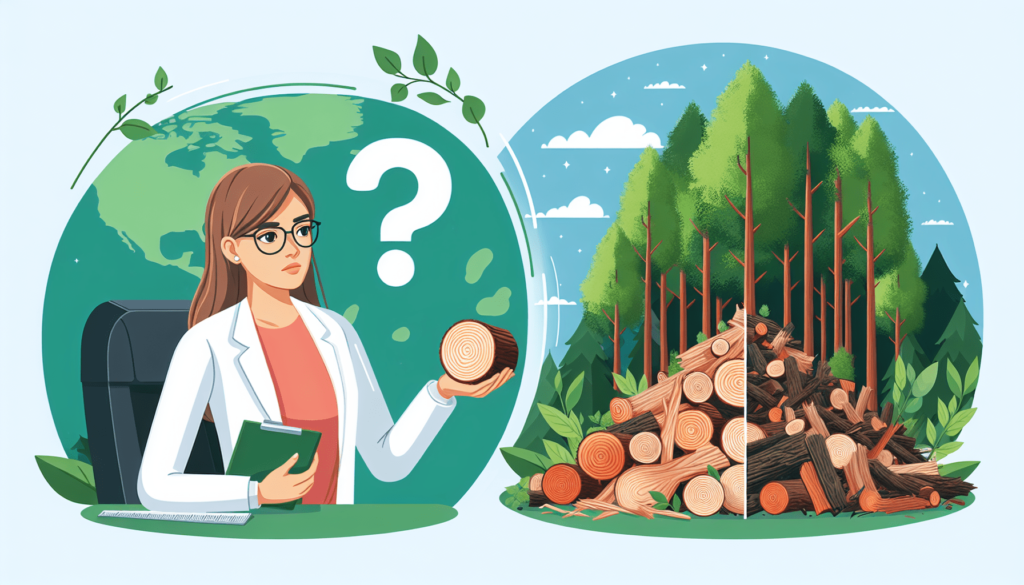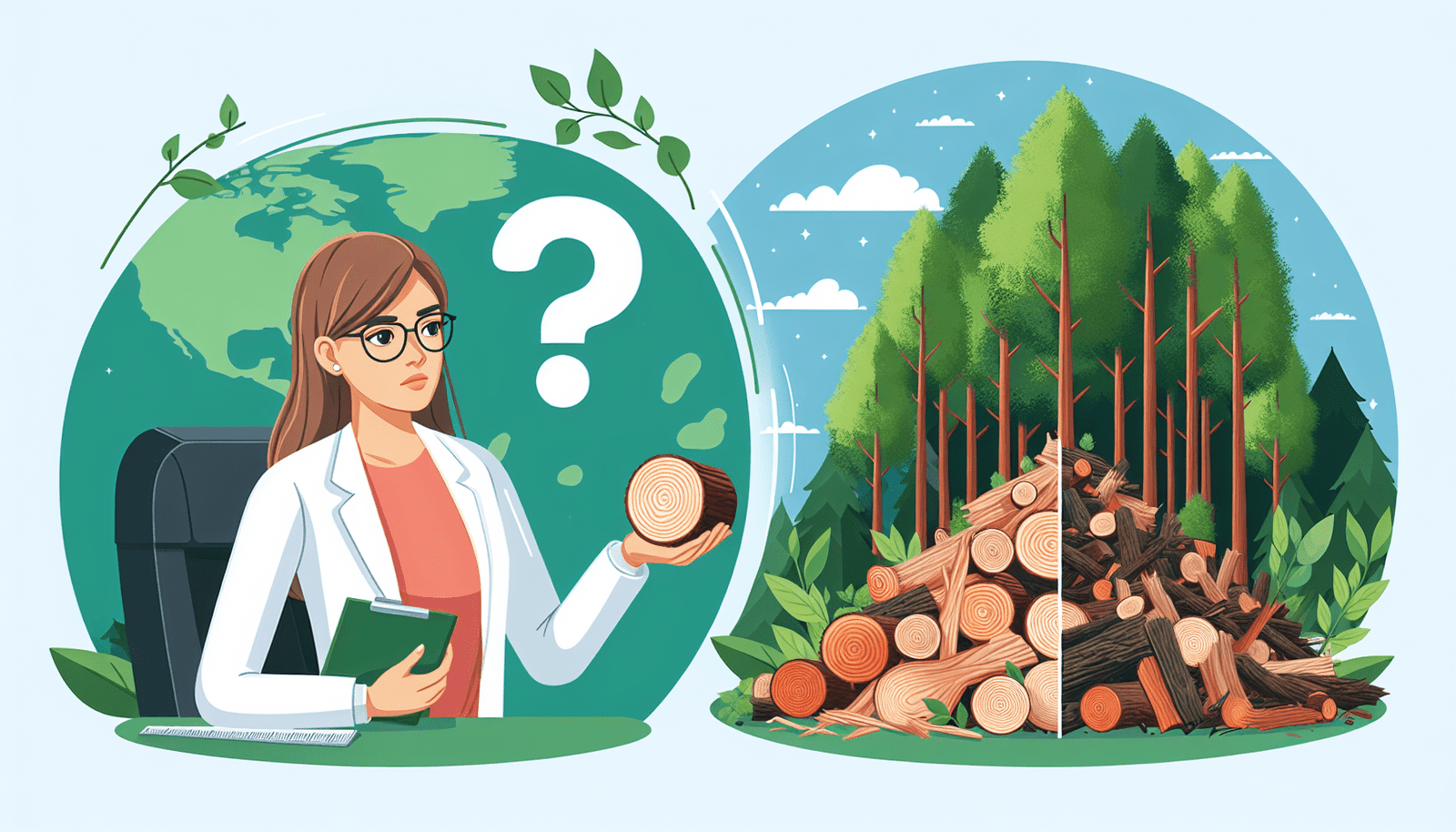Did you know that even though wood is a renewable resource, its waste can still have negative effects on the environment? While wood waste can be repurposed and recycled, the improper disposal of it can lead to a variety of environmental issues. From deforestation and habitat destruction to greenhouse gas emissions, the impact of wood waste on the environment is a topic that deserves attention. In this article, we will explore the various ways in which wood waste can be harmful and seek sustainable solutions to minimize its negative impact.

Impacts of Wood Waste on the Environment
Wood waste can have significant negative impacts on the environment. The improper management and disposal of wood waste can contribute to deforestation, air pollution, water pollution, and habitat destruction. Understanding these impacts is essential for implementing effective strategies to mitigate the environmental harm caused by wood waste.
Deforestation
One of the primary impacts of wood waste is deforestation. The excessive extraction of wood resources leads to the depletion of forests and an overall loss of biodiversity. Trees play a crucial role in maintaining the balance of ecosystems, providing habitats for various plant and animal species. When forests are cleared for wood production or improperly managed, the ecosystem’s equilibrium is disrupted, leading to a decline in biodiversity.
Additionally, deforestation caused by wood waste contributes to climate change. Trees act as carbon sinks, absorbing carbon dioxide from the atmosphere and helping to regulate the planet’s temperature. When forests are destroyed, the stored carbon is released back into the atmosphere, exacerbating the greenhouse effect and accelerating climate change.
Furthermore, improper management and disposal of wood waste can result in soil erosion. Without the stabilizing effect of tree roots, soil becomes vulnerable to erosion through wind and water. Soil erosion leads to the loss of fertile topsoil, which is vital for plant growth. The degraded soil quality can have long-term negative consequences for agricultural productivity and ecosystem health.
Air Pollution
Wood waste also contributes to air pollution, primarily through the emission of greenhouse gases, particulate matter, and volatile organic compounds (VOCs). When wood waste is burned, whether intentionally or unintentionally, it releases carbon dioxide, methane, and other greenhouse gases into the atmosphere. These gases enhance the greenhouse effect and contribute to global warming.
Particulate matter, such as soot, is another type of air pollutant produced by wood waste. Small particles released during wood combustion can penetrate deep into the lungs when inhaled, causing respiratory problems and exacerbating existing respiratory conditions, such as asthma.
Volatile organic compounds (VOCs) are chemicals that evaporate at room temperature, contributing to poor air quality. Wood waste can release VOCs during decomposition, paint or varnish removal, or burning. In high concentrations, VOCs can lead to adverse health effects, including eye, nose, and throat irritation, as well as headaches and nausea.
Water Pollution
Wood waste can also have detrimental effects on water quality, primarily through chemical contamination and sedimentation. When wood waste comes into contact with water, chemicals such as preservatives, paints, or stains can leach into the water, leading to contamination. These chemicals can be harmful to aquatic life and can accumulate in the food chain, posing risks to human health as well.
Sedimentation is another consequence of wood waste in water bodies. Improperly disposed wood waste can be washed into rivers, streams, or lakes during rain events, leading to sediment buildup. Sedimentation can reduce water clarity, disrupt aquatic ecosystems, and affect the growth and survival of aquatic plants and animals.
The impact of wood waste on aquatic life is significant. The chemicals released from wood waste can be toxic to fish, amphibians, and other aquatic organisms. These pollutants can impair reproductive capabilities, cause mutations, and even lead to the death of sensitive species. The disruption of the aquatic ecosystem can have far-reaching consequences on both the environment and human populations that rely on these water sources for drinking water and recreational activities.
Habitat Destruction
Another critical impact of wood waste is habitat destruction. As previously mentioned, when forests are cleared for wood production or improperly managed, numerous wildlife species lose their natural habitats. The destruction of habitats can directly lead to the loss of wildlife populations, including both plant and animal species.
Habitat destruction also contributes to the fragmentation of ecosystems. As forests are cleared or broken up into smaller patches, the overall connectivity between habitats decreases. This fragmentation disrupts the movement and migration patterns of wildlife, making it more challenging for species to find suitable habitat and access food and resources. The fragmentation of ecosystems can lead to a decline in biodiversity and an increased vulnerability to extinction for many species.
Furthermore, the destruction of habitats through wood waste impacts food chains and the overall functioning of ecosystems. Many species rely on forests for food and shelter, and when these habitats are destroyed or degraded, the ripple effects can be felt throughout the entire ecosystem. The disruption of food chains can lead to imbalances in predator-prey relationships, population declines, and cascading effects on the health and stability of the ecosystem as a whole.
Wood Waste Management Strategies
To mitigate the negative impacts of wood waste on the environment, it is crucial to implement effective management strategies. These strategies should focus on reducing the amount of wood waste generated, reusing and recycling wood waste whenever possible, and exploring alternative uses, such as energy generation and composting.
Reduce
The first strategy to manage wood waste is to reduce its generation. This can be achieved through efficient production practices that minimize waste during the manufacturing process. Additionally, promoting sustainable forestry practices can help ensure responsible wood harvesting, reducing the overall demand for new wood resources and minimizing waste generation.
Furthermore, individuals and businesses can contribute to wood waste reduction by minimizing their wood consumption. This can be achieved through conscious purchasing decisions, opting for durable and long-lasting wood products, and choosing alternative materials when feasible.
Reuse
Reuse is another effective strategy for managing wood waste. By repurposing wood waste, such as using it for construction or furniture making, it can be given new life and extend its usefulness. Salvaging and reclaiming wood from demolished structures or old furniture can also be a sustainable way to reuse wood waste.
Recycle
Wood recycling processes are crucial for managing wood waste and minimizing its environmental impact. Through recycling, wood waste can be turned into useful products, such as mulch, composite materials, or even new wood products. Recycling reduces the demand for virgin wood resources and helps conserve natural forests.
Additionally, wood waste can generate valuable byproducts during the recycling process. These byproducts, such as wood chips or sawdust, can be used in the production of biofuels, particleboards, or other construction materials, further reducing waste and promoting a circular economy.
Composting
Composting wood waste is another effective strategy to manage its environmental impact. When wood waste is composted, it can be turned into nutrient-rich organic matter that can be used as a soil amendment. This benefits agriculture, landscaping, and gardening by improving soil fertility and structure, reducing the need for synthetic fertilizers and enhancing water retention in the soil.
The composting process involves breaking down the wood waste through the activity of microorganisms, such as bacteria and fungi, in the presence of oxygen and moisture. Composting wood waste requires proper management and monitoring of temperature, moisture levels, and carbon-to-nitrogen ratio to ensure efficient decomposition.
In conclusion, wood waste can have significant negative impacts on the environment, including deforestation, air pollution, water pollution, and habitat destruction. However, through effective management strategies like reducing, reusing, recycling, energy generation, and composting, these impacts can be mitigated. Taking a comprehensive approach to wood waste management is crucial in protecting the environment and promoting sustainability. By adopting responsible practices and considering alternative uses for wood waste, we can work towards a more environmentally friendly and sustainable future.

Hi, I’m James Gheen, the creator behindWoodRebirth.com. As someone passionate about sustainability and environmental stewardship, I created this pioneering online platform to change how we approach wood waste and pallet disposal. Through detailed recycling and disposal guides, creative DIY projects, and upcycling inspirations, I aim to inspire individuals and businesses to adopt eco-friendly practices in their wood waste management. At WoodRebirth.com, we foster a vibrant community focused on education and engagement, encouraging the sharing of ideas and success stories. Join me in our mission to give wood waste a new lease on life, making a tangible impact on our environment, one pallet at a time.

